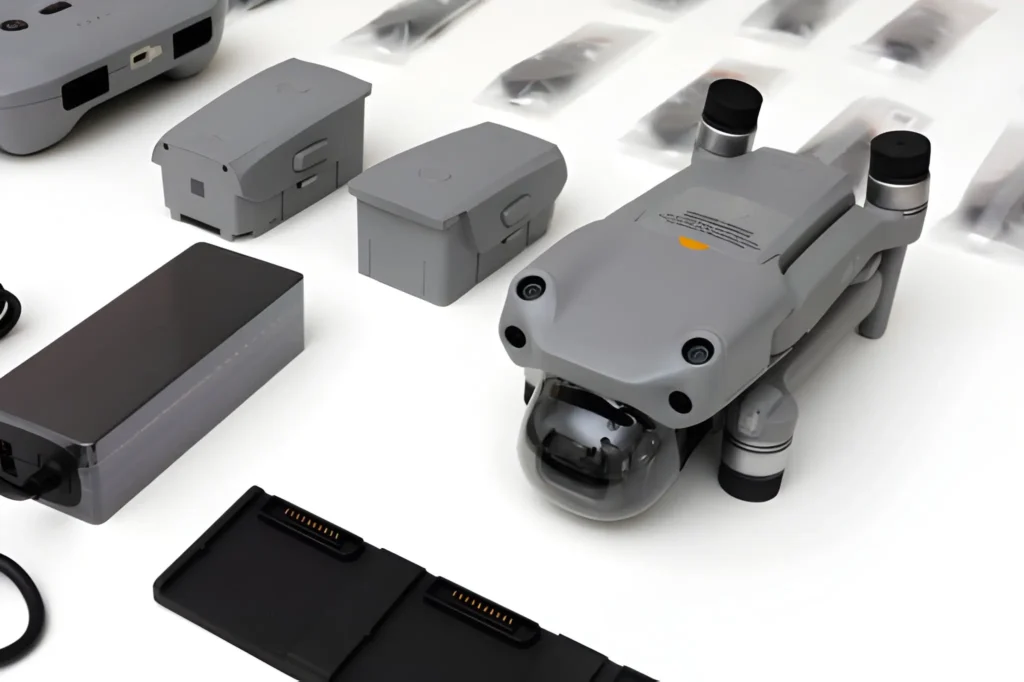Flight time limits frustrate drone operators constantly. You’re finally getting smooth footage or completing a mapping mission, and the low battery warning forces an early return. Standard DJI batteries give you 20-30 minutes depending on the model and conditions, but that includes safety margins and return-to-home reserves. Actual useful flight time might be 15-20 minutes. High capacity batteries for DJI push those numbers up significantly—some aftermarket options add 30-50% more flight time by packing more energy into slightly larger form factors. But more capacity comes with tradeoffs that affect handling, compliance, and safety.
Energy Density and Battery Chemistry
Lithium polymer cells store energy based on their chemical composition and physical design. Standard DJI batteries use cells with energy density around 260-280 Wh/kg. High capacity upgrades use optimized cell chemistry reaching 300-320 Wh/kg, cramming more power into the same weight.
Cell configuration matters too. A 3S battery (11.4V nominal) uses three cells in series. Adding capacity means increasing the amp-hour rating—standard might be 3850mAh while high capacity hits 5000mAh+. This requires physically larger cells or more efficient energy storage tech.
The voltage curve affects usable capacity. A battery might claim 5000mAh, but the drone’s voltage cutoff (usually around 3.0V per cell) means you can’t drain it completely. Effective usable capacity is maybe 80-85% of rated capacity. Better cells maintain higher voltage under load, delivering more usable power.
Weight Penalties and Flight Dynamics
Physics doesn’t let you cheat. More capacity means more weight, typically 20-40 grams extra per 1000mAh increase. On a Mavic 3 where the standard battery weighs 335g, a 6000mAh upgrade might hit 385-400g. That’s a 15-20% weight increase.
This weight affects flight characteristics. Heavier drones have more inertia, making quick directional changes slightly sluggish. It’s subtle but noticeable in sport mode or when tracking fast-moving subjects. The motors work harder maintaining position, especially in wind.
Some pilots expect proportional flight time increases—if you add 30% capacity, you should get 30% more flight time, right? Not quite. The extra weight increases power consumption by maybe 8-12%, so actual gains are closer to 18-22% more flight time. Still worth it for many applications, but understand the math.
Regulatory and Compliance Issues
Battery capacity affects regulations in ways most people ignore. Many countries limit drone batteries to 100Wh for transport without special handling. A 3S 5000mAh battery is about 57Wh (11.4V x 5Ah). But a 6500mAh version hits 74Wh. An 8000mAh battery crosses 90Wh and starts triggering additional restrictions.
Air travel rules get stricter. You can carry spare batteries under 100Wh in checked or carry-on luggage with restrictions. Batteries 100-160Wh require airline approval and have quantity limits. High capacity batteries might complicate professional travel logistics.
Some aftermarket batteries skip certification entirely. DJI batteries carry CE, FCC, and UN38.3 certifications proving they meet safety standards. Random Chinese sellers on marketplaces might not test batteries properly. Uncertified batteries using substandard cells create fire risks.
Compatibility and Firmware Limitations
DJI flight controllers expect specific battery parameters. The intelligent battery management system reports capacity, voltage, cell count, and health data to the drone. Aftermarket batteries need compatible firmware or the drone refuses to arm.
Some manufacturers clone DJI’s battery communication protocol, making their batteries appear legitimate to the flight controller. This works until DJI pushes firmware updates that include new authentication checks. Suddenly your $80 battery won’t work, and you’re stuck buying official replacements.
Voltage cutoffs sometimes cause problems. If an aftermarket battery reports slightly different voltage curves, the drone might initiate emergency landing sooner than necessary, wasting capacity. Or worse, it might allow deeper discharge than safe, risking cell damage or fire.
Performance Testing and Real-World Results
Claimed capacity often exceeds actual performance. A battery labeled 6000mAh might test closer to 5400-5600mAh under proper discharge testing. Manufacturers sometimes rate capacity at unrealistic discharge rates that don’t match drone power demands.
Temperature affects capacity significantly. Cold weather (below 10°C) reduces usable capacity by 15-25%. The battery voltage sags under load, triggering low voltage warnings earlier. High capacity batteries with better cell quality handle cold slightly better but still suffer.
Pilot behavior matters more than people admit. Aggressive flying in sport mode, frequent direction changes, and fighting wind all increase power consumption. A high capacity battery used aggressively might deliver less flight time than a standard battery flown smoothly in normal mode.
Maintenance and Cycle Life Considerations
Higher capacity batteries typically offer better cycle life because they’re discharged less deeply per flight. If you fly for 20 minutes, a 5000mAh battery drops to 40% capacity while a 6500mAh battery stays around 55%. Shallower discharge cycles mean less stress per use.
Storage voltage matters even more with high capacity batteries. Keeping them at full charge degrades cells faster. The standard 60% storage charge is harder to estimate with aftermarket batteries lacking auto-discharge. You need to manually discharge or charge to proper levels.
Balancing larger capacity batteries takes longer. If cells drift out of balance, the charger spends extra time moving charge between cells to equalize voltages. This can extend charge times by 10-20 minutes compared to well-maintained standard batteries.
Also Read-How to Successfully Sell Your Car in Perth







